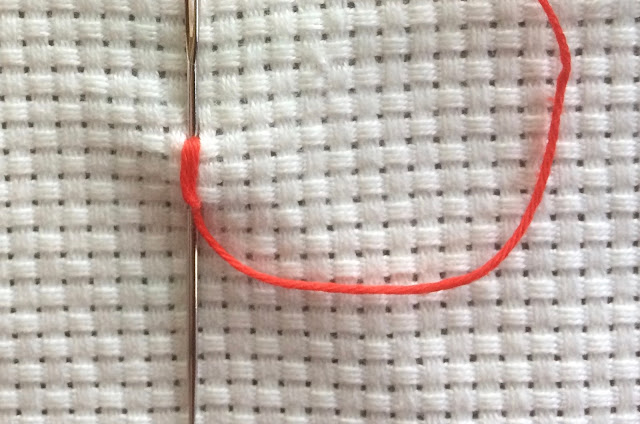On the request of a student, we are today changing to another subject, Biology, and will study grains.
We will cling on to Geography in a sense, and also branch into Geology and Languages.
Today's stitch is called Granitos.
Many sources claim it stands for little grain in Spanish. My online dictionary, though, says grain is called grano in Spanish, and granito means granit. Could it mean a grain of granit = sand?
I'd welcome feedback from any reader with knowledge of Spanish, or the origin of the name.
The only name I have found for this stitch in Japan is the 'Japanglish' プレーンナットステッチ, Plain Knot Stitch. This is totally incorrect as there is not one single knot involved, plain or (k)not!
Updated: Point de Granitos or Point de Petits Grains are the French names. Thank you Mattia.
On my Aida sampler the Granitos look like this:

Work it like this:
An odd number of straight stitches are worked between the same two holes.

Make one straight stitch,

place the second on the left,
the third on the right

and so on
building the stitch full and fat.
Annet has a nifty way to tame the thread.
Homework:
Use this stitch creatively. Remember this lesson is Biology!




16 comments:
"Ito" is the masculine ending meaning small, so it does make sense that
"granito" means little grain. The stitch looks like a little grain, so that also makes sense to name it little grain. Some things aren't logical though, so don't count on what I just wrote.
It has been many years since I used my Spanish but to me, that ending means "small"
Great feedback! I checked out an online Spanish grammar and, yes, your explanation makes good sense, and the stitch does look like a little grain.
Thank you, Pamela.
Thank you for your information. Yes, I see that this ending would be used for nouns to indicate that they are small.
I'm looking forward to seeing what you do with your Little Grains!
Pressure, pressure....!
I have yet to put on my thinking cap!
Another stitch I've not done before [that I can remember anyhow]
I think it would make beautiful, plump petals, or berries, or beans, or eyeballs (especially on animals)....
Little grain stitch looks to be very useful in 'biological' subjects, I agree.
I've seen it used before as textured filler. Good choice.
A textured filler, eh? I think it would be difficult to do these stitches too close and packed together without grabbing hold of the stitches nearby...
Such a lovely stitch, this post is a great reminder to use it. Thanks for the link to my tip!
I like this stitch; I came across it while ago. It is so easy, but so useful.
xx
With very little effort, especially when using your trick with the needle, you get this plump nice stitch.
Yes, it is a great stitch, easy to do and with instant satisfaction!
J'aime ce point que j'utilise régulièrement -
le nom français de ce point est :
- point de granitos ou point de petits grains
Mattia
Thank you for the info. I will update the blog.
Post a Comment